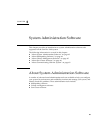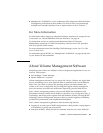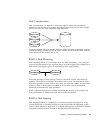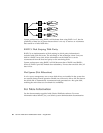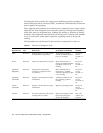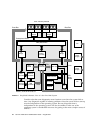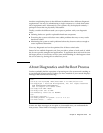
Chapter 5 System Administration Software 71
Instructions for attaching and configuring hardware to access the system console are
given in Chapter 7. The following subsections, “Default System Console
Configuration” on page 71 and “Alternative System Console Configuration” on
page 71, provide background information and references to instructions appropriate
for the particular device you choose to access the system console.
Default System Console Configuration
On Sun Fire V490 servers, the system console comes preconfigured to allow input
and output only by means of an alphanumeric terminal or tip line attached to the
system’s built-in serial port, ttya. This provides for secure access at the installation
site.
Using a tip line may be preferable to connecting an alphanumeric terminal, since
tip lets you use windowing and operating system features.
For instructions on setting up an alphanumeric terminal as the system console, see
“How to Set Up an Alphanumeric Terminal as the System Console” on page 133.
For instructions on accessing the system console via a tip line, see “How to Access
the System Console via tip Connection” on page 129.
Alternative System Console Configuration
After initial system installation, you can configure the system console to communicate
via alternative devices, including a local graphics terminal, or the system controller.
To use a device other than the built-in serial port as the system console, you need to
reset certain of the system’s OpenBoot configuration variables and properly install
and configure the device in question.
Using a Local Graphics Terminal as the System Console
The Sun Fire V490 server is shipped without a mouse, keyboard, monitor, or frame
buffer for the display of graphics. To install a local graphics terminal on the server,
you must install a graphics frame buffer card into a PCI slot, and attach a monitor,
mouse, and keyboard to the appropriate back panel ports.
After starting the system you may need to install the correct software driver for the
card you have installed. For detailed hardware instructions, see “How to Configure
a Local Graphics Terminal as the System Console” on page 135.



